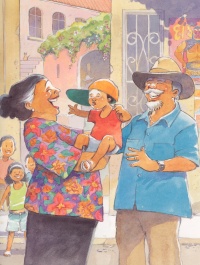| ________________
CM . . .
. Volume XIII Number 18 . . . . April 27, 2007
excerpt:
Robert Munsch and Michael Martchenko continue to tickle the funny bone with their trademark unpredictability and visual humour in their new picture book, Class Clown. Leonardo has been making people laugh from infancy. His mother, grandparents, friends and even strangers agree that, throughout his life, "Leonardo is sooooo funny!" But, when Leonardo is in grade one, his teacher, Mrs. Gomez, tells him he has to stop being funny. The children, she explains, are laughing all the time and are not learning anything. Though Leonardo tries, he cannot stop being funny. The resulting confusion and hyperbole will be sure to start giggles as the reader anticipates the outcome. Though Class Clown is an appropriate early reader book, its real strength is as a read-aloud story. The rhythm of the language and the repetition will have the audience participating and anticipating the next page. By providing visual textual clues, such as bold or capitalized words, Munsch effectively prompts the reader to add emotion and expression when reading independently or aloud. The pictures also contribute to an excellent read-aloud story.
Michael Martchenko's watercolour illustrations enhance the storyline by providing wonderful characterization. Colours of yellows and blues create a happy, confident mood to act as a backdrop to allow the characters, dressed in hues of other primary colours such as red and green, to jump off the page. Excellent use of background detail creates a unique stage for Leonardo to perform. Expressive faces and gestures of even minor characters draw the reader into the tale. Martchenko is particularly good at using the eyes and mouth of his characters to express emotion. As in any good partnership, Munsch and Martchenko each build on the strengths of the other. So, it is a delightful treat when Munsch's text deftly passes the last laugh to Martchenko whose illustrations on the last page provide an unexpected twist, one which, incidentally, will allow a teacher to hold a fun discussion about what children want to be when they grow up. My co-readers were a group of grade two students. They thought it was very silly that a teacher would tell someone not to think and not to remember in school. Class Clown quickly became another of the many Munsch-Martchenko hits circulating the classroom. Highly Recommended. Jonine Bergen is a library technician at the Millennium Library in Winnipeg, MB.
To comment on this
title or this review, send mail to cm@umanitoba.ca.
Copyright © the Manitoba Library Association. Reproduction for personal
use is permitted only if this copyright notice is maintained. Any
other reproduction is prohibited without permission.
NEXT REVIEW |TABLE OF CONTENTS FOR THIS ISSUE
- April 27, 2007.
AUTHORS
| TITLES | MEDIA REVIEWS
| PROFILES
| BACK ISSUES
| SEARCH | CMARCHIVE
| HOME |

